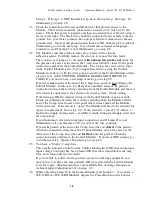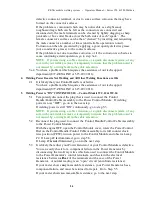
ZENA mobile welding system -- Operators Manual -- Series 150 & 200 Welders
20
20
that the gray wires connecting the Control Module to the Power Generator may
have been accidentally shorted to ground while connecting or disconnecting
these leads with power “on” to the Control Module, OR that a voltage higher
than 14.5VDC (or 29VDC in 24V systems) has been accidentally applied to the
Control Module. Go on to the next step.
2.11 You can easily check for a component failure in the Power Generator by
disconnecting the two Gray wires which are used to connect the Control Module
to the Power Generator’s control terminals, and check in the electrical
resistance between these control terminals with an ohm meter. A normal
reading is between 1.4 and 2.4 ohms. If your meter shows a resistance of
less
than 1.4 ohms
, your Power Generator has a component failure, and must be
returned for repair. Go to Step 2.9.
If the electrical resistance measured between the control terminals is
higher
than the “normal” range of 1.4 to 2.4 ohms
(for example, 10 ohms or 20
ohms or more) it is an indication of grease or some similar material which has
caused “fouling” coating of the brushes and or internal slip-rings. Cleaning can
be accomplished in the field, if necessary, but is best done under factory
conditions. Such cleaning, will be performed free of any labor charge, with
charges only for return freight cost. Go to Step 2.9.
If your electrical resistance between the control terminals is correct, you should
also measure the electrical resistance between either of the terminal and the
case of the Power Generator. A normal reading is an “open” circuit (an infinite
resistance). If your meter shows any measurable resistance, your Power
Generator has a component failure, and must be returned for repair. Go to Step
2.9.
If all resistance readings at the control terminals are correct, simply replacing
the fuse in the Control Module will likely solve the problem.
If you are able to solder, and if you have access to soldering equipment, you
may choose to replace the 10 amp. Control Module fuse yourself (replacement
fuses are available free of charge through our technical support department),
OR you may (providing you insure that 7.5 to 8A external fuse is installed and
functioning in the supply circuit to protect the Control Module) solder a suitably
sized wire across the 10A fuse leads (shorting the 10A fuse so that power may
be transmitted across it), OR you can return the Control Module to us for 10A
fuse replacement. (In this case, it may also be advisable to return the Power
Generator along with the suspect Control Module for inspection and/or repair.)
If you choose to return the Module, go to step 2.9.
If the fuse is replaced, AND if the fuse “blows” again -- AND if you are sure
that the gray wires connecting the Control Module to the Power Generator have
not been accidentally shorted to ground while connecting or disconnecting these
leads (with power “on” to the Control Module), AND/OR that a voltage higher
than 14.5VDC (or 29VDC in 24V systems) has not been accidentally applied to
the Control Module, go to step 2.9.
2.12 You can easily check for a component failure in the Power Generator by
disconnecting the two Gray wires which are used to connect the Control Module
to the Power Generator’s control terminals, and check in the electrical
resistance between these control terminals with an ohm meter. A normal
reading is between 1.4 and 2.4 ohms. If your meter shows a resistance of
less
Содержание 150 series
Страница 2: ......
Страница 5: ......
Страница 6: ......
Страница 12: ...ZENA mobile welding system Operators Manual Series 150 200 Welders 6 6 This page intentionally left blank...
Страница 35: ...ZENA mobile welding system Operators Manual Series 150 200 Welders 29 29 This page intentionally left blank...
Страница 37: ...ZENA mobile welding system Operators Manual Series 150 200 Welders 31 31 This page intentionally left blank...













































